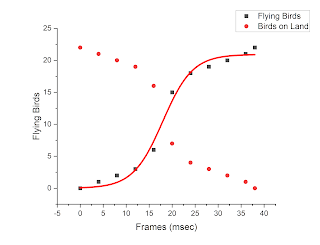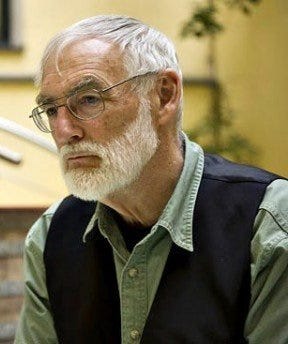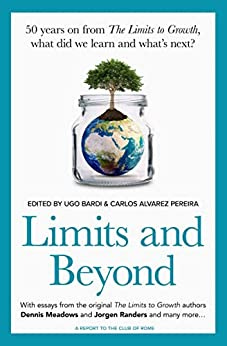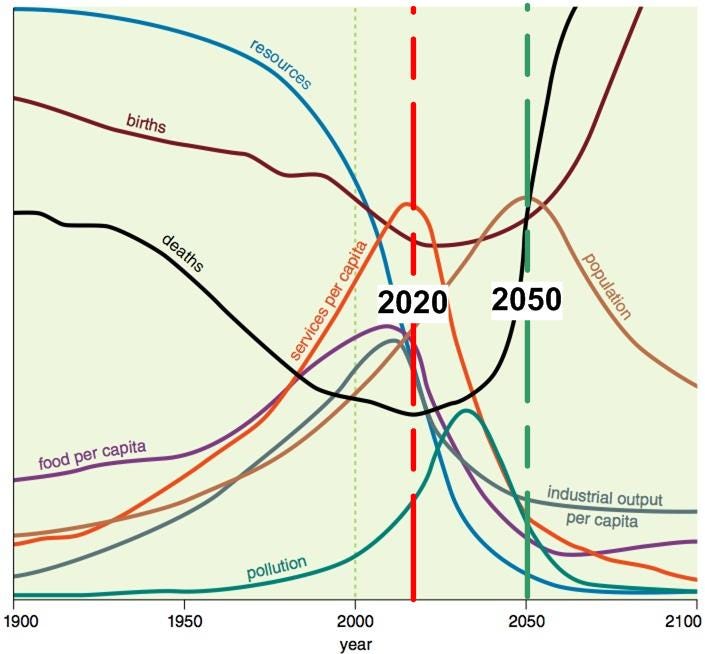The 50th anniversary of the publication of "The Limits to Growth," in 1972, continues to generate interest. This is the original English version of the article by Jeffrey Sachs published in Italian on "Il Sole 24 Ore" -- courtesy of Susana Chacon. Above, the cover of the recent report to the Club of Rome, "Limits and Beyond", that re-examines the 1972 study and discusses its relevance for us
From Limits to Growth to Regeneration 2030
Jeffrey D. Sachs | May 26, 2022 | Il Sole 24 Ore
Fifty years ago, Italian business leaders in the Club of Rome gave a jolt to the world in their path-breaking report
Limits to Growth. That thought leadership continues today as
Italian business leaders launch Regeneration 2030, a powerful call for
more holistic, ethical, and sustainable business practices to help the
world achieve the Sustainable Development Goals
(SDGs) and the Paris Climate Agreement. The 50-year journey from
Limits of Growth
to Regeneration 2030 shows how far we have come in understanding the
critical challenges facing humanity, but also how far we still have to
go to meet those challenges.
The half-century since
Limits to Growth also defines my own
intellectual journey, since I began university studies at Harvard
University exactly 50 years ago as well. One of the first books that I
was assigned in my introductory economics course was
Limits to Growth. The book made a deep and lasting impression
on me. Here for the first time was a mathematical simulation of the
world economy and nature viewed holistically, and using new systems
dynamics modeling then underway at the Massachusetts
Institute of Technology (MIT).
Limits to Growth warned that compound economic growth was on a
path to overshoot the Earth’s finite resources, leading to a potential
catastrophe in the 21
st century. My professor huffily
dismissed the book and its dire warning. The book,
the professor told us, had three marks against it. First, it was
written by engineers rather than economists. Second, it did understand
the wonders of a self-correcting market system. Third, it was written
at MIT, not at Harvard! Even at the time, I was
not so sure about this easy dismissal of the book’s crucial warning.
Fifty years later, and after countless international meetings,
conferences, treaties, thousands of weighty research studies, and most
importantly, after another half-century of our actual experience on the
planet, we can say the following. First, the growing
world economy is indeed overshooting the Earth’s finite resources.
Scientists now speak of the global economy exceeding the Earth’s
“planetary boundaries.” Second, the violation of these planetary
boundaries threatens the Earth’s physical systems and therefore
humanity itself. Specifically, humanity is warming the climate;
destroying the habitat of millions of other species; and polluting the
air, freshwater systems, soils, and oceans. Third, the market economy by
itself will not stop this destruction. Many of
the most dangerous actions – such as emitting climate-changing
greenhouse gases, destroying native forests, and adding chemical
nutrients to the rivers and estuaries – do not come with market signals
attached. Earth is currently treated as a free dumping
ground for many horrendously destructive practices.
Twenty years after
Limits to Growth, in 1992, the world’s
governments assembled at the Rio de Janeiro Earth Summit to adopt
several environmental treaties, including the UN Framework Convention on
Climate Change (UNFCCC) and the Convention on Biological
Diversity. Twenty years later, in 2012, the same governments
re-assembled in Rio to discuss the fact that the environmental treaties
were not working properly. Earth, they acknowledged, was in growing
danger. At that 2012 summit they committed to establish
Sustainable Development Goals (SDGs) to guide humanity to safety. In
2015, all 193 UN member states adopted the SDGs and a few weeks later
signed the Paris Climate Agreement to implement the 1992 climate treaty.
In short, we have gone a half-century from the first warnings to today.
We have adopted many treaties and many global goals, but in practice,
have still not changed course. The Earth continues to warm, indeed at
an accelerating rate. The Earth’s average
temperature is now 1.2°C warmer than in the pre-industrial period
(dated as 1880-1920), and is higher than at any time during the past
10,000 years of civilization. Warming has accelerated to more than
0.3°C per decade, meaning that in the next decade we
will very possibly overshoot the 1.5°C warming limit that the world
agreed to in Paris.
A key insight for our future is that we now understand the difference
between mere “economic growth” and real economic progress. Economic
growth focuses on raising traditional measures of national income, and
is merely doing more of what we are already doing:
more pollution, more greenhouse gas emissions, more destruction of the
forests. True economic progress aims to raise the wellbeing of
humanity, by ending poverty, achieving a fairer and more just economy,
ensuring the quality education for all children, preventing
new disease outbreaks, and increasing living standards through
sustainable technologies and business practices. True economic progress
aims to transform our societies and technologies to raise human
wellbeing.
Regeneration 2030 is a powerful business initiative led by Italian
business leaders committed to real transformation. Regeneration aims to
learn from nature itself, by creating a more circular economy that
eliminates wastes and pollution by recycling, reusing,
and regenerating natural resources. Of course, an economy can’t be
entirely circular – it needs energy from the outside (otherwise
violating the laws of thermodynamics). But rather than the energy
coming from digging up and burning fossil fuels, the energy
of the future should come from the sun (including solar power, wind,
hydroelectric, and sustainable bioenergy) and from other safe
technologies. Even safe man-made fusion energy may be within technical
and economical reach in a few decades.
On my part, I am trying as well to help regenerate economics, to become a
new and more holistic academic discipline of sustainable development.
Just as business needs to be more holistic and aligned with the SDGs,
economics as an intellectual discipline needs
to recognize that the market economy must be embedded within an ethical
framework, and that politics must aim for the common good. Scientific
disciplines must work together, joining forces across the natural
sciences, policy sciences, human sciences, and
the arts. Pope Francis has spurred the call for such a new and
holistic economics by encouraging young people to adopt a new “Economy
of Francesco,” inspired by the love of nature and humanity of St.
Francis of Assisi.
Sustainable Development, Regenerative Economy, and the Economy of
Francesco are, at the core, a new way of harnessing our know-how, 21
st
century technologies, and ethics, to promote human wellbeing. The
first principle is the common good – and that
means that we must start with peace and cooperation. Ending the war in
Ukraine at the negotiating table without further delay, and finding
global common purpose between the West and East, is a good place for us
to begin anew.
Published in
Il Sole 24 Ore for the Trento Festival of Economics, June 4, 2022


























